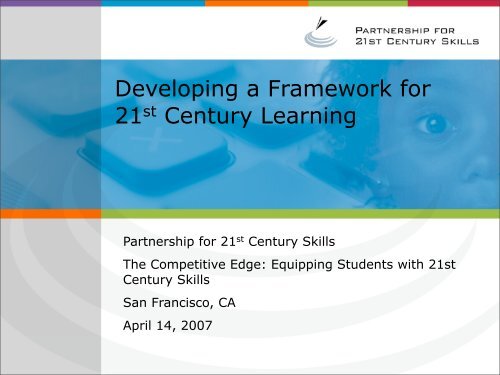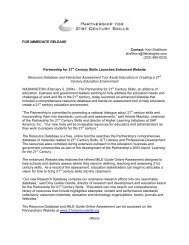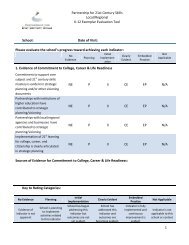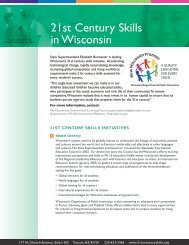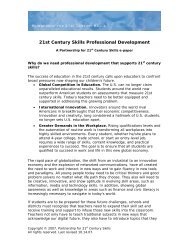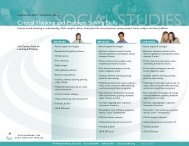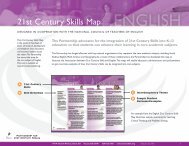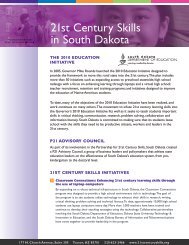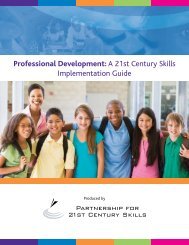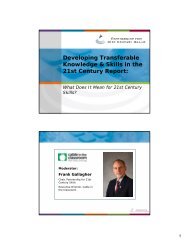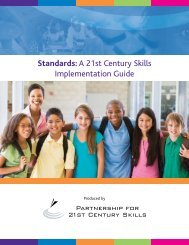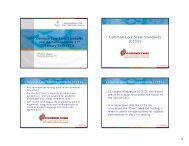A New Vision for 21st Century Education - The Partnership for 21st ...
A New Vision for 21st Century Education - The Partnership for 21st ...
A New Vision for 21st Century Education - The Partnership for 21st ...
You also want an ePaper? Increase the reach of your titles
YUMPU automatically turns print PDFs into web optimized ePapers that Google loves.
Developing a Framework <strong>for</strong>21 st <strong>Century</strong> LearningA <strong>New</strong> <strong>Vision</strong> <strong>for</strong>21 st <strong>Century</strong> <strong>Education</strong>[Insert <strong>Partnership</strong> Presenter <strong>for</strong> Name] 21 st <strong>Century</strong> Skills[Insert<strong>The</strong> CompetitivePresenter Title &Edge:Company]Equipping Students with <strong>21st</strong>[Insert <strong>Century</strong> Event Skills Name][Insert San Francisco, Date] CAApril 14, 2007PLEASE NOTE: This is only a template presentation; you may add examples and additionalslides based on your audience EDUCATION COMMUNITY AUDIENCE
Today Who is the <strong>Partnership</strong>? Why are 21 st century skills so critical? What is the framework <strong>for</strong> 21 st century skills? How do we Assess <strong>21st</strong> <strong>Century</strong> Skills? How do we provide Professional Development? What is “Route 21”? What can educators do?
“This is a story about the big publicconversation the nation is nothaving about education… whetheran entire generation of kids will failto make the grade in the globaleconomy because they can’t thinktheir way through abstractproblems, work in teams,distinguish good <strong>for</strong>mation frombad, or speak a language otherthan English.”How to Build a Student <strong>for</strong> the21 st <strong>Century</strong>,TIME Magazine, December 18,2006
Why are 21 st <strong>Century</strong> Skills important?• <strong>The</strong> magnitude of our competition is changing. We need toimprove our global competitive position and develop within theglobal community.• <strong>The</strong> demands of the workplace are changing.• <strong>The</strong> nature of student experience has changed outside ofschool.• We need many more of our students to become effective 21 st<strong>Century</strong> Citizens with lifelong teaching and learning skills.
Who is the <strong>Partnership</strong>?
Work<strong>for</strong>ce Readiness Survey“Are <strong>The</strong>y Really Ready toWork?”Released October 2, 2006<strong>The</strong> Conference BoardCorporate Voices <strong>for</strong> Working Families<strong>Partnership</strong> <strong>for</strong> 21 st <strong>Century</strong> Skills<strong>The</strong> Society <strong>for</strong> Human Resource Management.
Work<strong>for</strong>ce Readiness SurveyWhat skills and content areas will be growing inimportance in the next five years?Critical Thinking 78%In<strong>for</strong>mation Technology 77%Health & Wellness 76%Collaboration 74%Innovation 74%Personal Financial Responsibility 72%
What is the Framework<strong>for</strong> 21 st <strong>Century</strong>Learning?
Framework <strong>for</strong> <strong>21st</strong> <strong>Century</strong> Skills
Framework <strong>for</strong> <strong>21st</strong> <strong>Century</strong> SkillsCore Subjects - NCLB• English• Reading & Language Arts• Mathematics• Science• Foreign Languages• Civics & Government• Economics• Arts• History• Geography
Framework <strong>for</strong> <strong>21st</strong> <strong>Century</strong> Skills21 st <strong>Century</strong> Content• Global Awareness• Financial, Economic, Business andEntrepreneurship Literacy• Civic Literacy• Health & Wellness Awareness<strong>21st</strong> <strong>Century</strong> ContentCore Subjects
Framework <strong>for</strong> <strong>21st</strong> <strong>Century</strong> SkillsThinking and Learning Skills• Critical Thinking & ProblemSolving Skills• Creativity & Innovation Skills• Communication Skills• Collaboration Skills• In<strong>for</strong>mation and Media Literacy
Framework <strong>for</strong> <strong>21st</strong> <strong>Century</strong> SkillsICT Literacy<strong>The</strong> ability to use technology to accomplish thinking &learning skills• Critical Thinking & ProblemSolving Skills• Creativity & Innovation Skills• Communication Skills• Collaboration Skills• In<strong>for</strong>mation and Media Literacy
Preparing Students <strong>for</strong> a Lifetime of SuccessLife Skills• Leadership• Ethics• Accountability• Adaptability• Productivity• Personal Responsibility• People Skills• Self Direction• Social Responsibility21 st <strong>Century</strong> ContentITC Literacy + Thinking &Learning Skills
Framework <strong>for</strong> <strong>21st</strong> <strong>Century</strong> Skills
Why is the assessment of 21 stcentury skills so important?
AssessmentWe are currently measuring 20 thcentury metrics.
AssessmentWe must measure 21 st centuryoutcomes and skills.
AssessmentWe need a balance of 21 st <strong>Century</strong>assessments(<strong>for</strong>mative and summative)
AssessmentWe need international benchmarking of21 st century skills.
Assessment21 st century skills must become thefuture of NCLB.
Assessment21 st century skills must become thefuture of NCLB.Examples:• Assessment of 21 st <strong>Century</strong>Skills: <strong>The</strong> Current Landscape• Route 21 (Fall of 2007)
Professional DevelopmentWhy is professionaldevelopment soimportant?
Professional Development<strong>The</strong>re is no school, district or statein the country that is focused on21 st century skills that doesn’t haveprofessional development as one ofits key strategies.
Professional DevelopmentSeven Habits <strong>for</strong> Quality 21 st<strong>Century</strong> Professional Development
Professional DevelopmentLeadership TrainingTrain administrators in 21 st centuryskills so that they can be effectiverole models and decision makers<strong>for</strong> integrating 21 st century skillsinto every aspect of teaching,learning and administration.
Professional DevelopmentIn-Service TrainingConsistent, and “just in time”preparation that includes coachingand identification of newpedagogical tools and approaches toweave 21 st century skills intocontent areas.
Professional DevelopmentICT LiteracyEnsure teachers have the tools andpedagogical support to be proficientin ICT literacy, so they can helpstudents develop this proficiency.
Professional DevelopmentEase of AccessEnsure educators have 24/7 access to21 st century tools that they canutilize <strong>for</strong> quality professionaldevelopment.
Professional DevelopmentPre-Service TrainingEnsure teacher educationinstitutions equip future teachers <strong>for</strong>21 st century instruction.
Professional DevelopmentAccreditationAdd competency in 21 st centuryskills to accreditation criteria <strong>for</strong>teacher education programs.
Professional Development21 st <strong>Century</strong> Teaching AcademiesCreate 21 st century teachingacademies, or other specialinitiatives, where teachers candevelop and renew 21 st century skillsand pedagogy in structuredprograms.
Route 21What is“Route 21”?
Route 21 Overview• Online interactive resource• Focus on supporting <strong>21st</strong> centuryskills in standards, assessments,curriculum (teaching & learning) andprofessional development• Helps state leaders and others on21 st century skills initiatives
Route 21 Components• Standards <strong>for</strong> the <strong>21st</strong> <strong>Century</strong> (Standards 21) – Casestudies, research, reports and other resources surroundingstandards-setting in the <strong>21st</strong> century• Assessment <strong>for</strong> the <strong>21st</strong> <strong>Century</strong> (Assess 21) – Anupdate of the existing Assess 21 tool to include emergingexamples of <strong>for</strong>mative assessment practices• Teaching & Learning <strong>for</strong> the <strong>21st</strong> <strong>Century</strong> (T&L 21) –Examples of how <strong>21st</strong> century skills can be taught in thecontext of core subjects• Professional Development <strong>for</strong> the <strong>21st</strong> <strong>Century</strong> (PD 21)– Document current best practices, case studies and researchthat will in<strong>for</strong>m professional development ef<strong>for</strong>ts
Route 21 Additional Features• Interactive Framework – Presentresources related to the P21 framework in agraphical, interactive <strong>for</strong>mat• Community Tools – Interactive socialnetworking and document sharing tools(user generated content, ranking, tagging,wikis, blogs etc.)• Resource Library — relevant reports,articles, research
Framework <strong>for</strong> <strong>21st</strong> <strong>Century</strong> Skills<strong>The</strong> ICT Literacy Maps helpdemonstrate what ICT literacylooks like inside:- Math- Science- English- Geography- Social Studies(2007)
Route 21What can educators do?5 Steps
What Can Educators Do?1. Focus your system on 21 stcentury outcomes <strong>for</strong>every student.
What Can Educators Do?2. Build a consensus around the21 st century skills with includebusiness leaders, communitygroups, parents, policymakers,etc.)
What should school boards do?3. Focus on High School Re<strong>for</strong>m.
What should school boards do?4. Focus on Professional Development.Example: Lawrence Township
What should school boards do?5. Focus on Assessment.Assessment of 21 st<strong>Century</strong> Skills:<strong>The</strong> CurrentLandscapeExamples:• John Brans<strong>for</strong>d• College Readiness and WorkAudit (CRWA)<strong>Partnership</strong> <strong>for</strong> 21 st <strong>Century</strong> Skillswww.<strong>21st</strong>centuryskills.org
What should school boards do?6. Collaborate with Community-Based Groups such as youthdevelopment and after-schoolprograms on a “communitystrategy” to pursue21 st <strong>Century</strong> Skills.
ConclusionEvery student in this nation must be:• A critical thinker• A problem solver• An Innovator• An effective communicator• An effective collaborator• A self-directed learner• In<strong>for</strong>mation and media literate• Globally aware• Civically engaged• Financially and economically literate
Conclusion“<strong>The</strong>re is remarkableconsensus amongeducators and businessand policy leaders onone key conclusion: weneed to bring what weteach and how we teachinto the <strong>21st</strong> century.”TIME Magazine,December 18, 2006
Who is the <strong>Partnership</strong>?
Contact Us<strong>The</strong> <strong>Partnership</strong> <strong>for</strong> 21 st <strong>Century</strong> Skillswww.<strong>21st</strong>centuryskills.org


